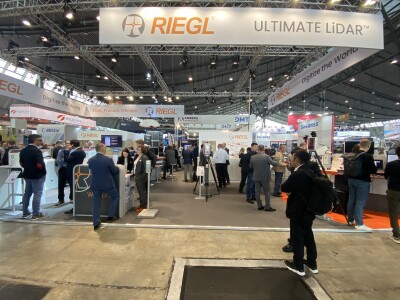ULS product portfolio overview
RIEGL's Uncrewed Laser Scanning (ULS) now includes multiple sensors. Most of them have been on the market for some time, such as the MiniVUX-1UAV and MiniVUX-3UAV. Both are entry-level, survey-grade lidar systems. Because they are light-weight, they are a good fit for small, multi-rotor UAVs and provide a good entry point into survey grade-accurate lidar. The VUX-1UAV, is also a light scanner with a 360 degree FOV, but has a higher accuracy and higher point density than the MiniVUX series sensors. From here is the evolution into the next generation of ULS scanning with the VUX-12023, that features an NFB (Nadir/Forward/Backward) scanning pattern for an optimal coverage of complex and vertical targets. The details of this scanning pattern are covered below.
The VUX-16023 also features the NFB scanning pattern mentioned earlier, and is a longer range-version of the VUX-12023, that can be used for both fixed-wing UAVs or even low-flying aircraft. The VUX-18024 was released earlier this year and has a scanning speed of 800 lines per second at nadir. Finally, the VQ-840-GL is RIEGL's bathymetric solution for heavier UAVs and helicopters, that is used for efficient, high-resolution coastline or shallow water surveying.
NFB Scanning Pattern for Complete Coverage
The figure below shows the three different scan patterns that form part of the NFB (Nadir-Forward-Backward) pattern, available for both the VUX-16023 and VUX-12023. It enables creating a dense and complete point cloud to illuminate as many shadows or missing data as possible.

The first pattern is the nadir scan pattern that allows users to pick up the top of things. However, there are angles like the side of buildings or poles that will not be picked up unless you’ve flown to the side of these. This explains the addition of a second and third pattern: the forward +10 degrees pattern enables picking up vertical facades, such as the side of buildings or power poles without having to fly offset from the building or power pole. It also provides a different angle to scan through vegetation. The final scan pattern is the backwards or the -10 degrees pattern, that allows you to pick up the backside of objects, such as the backside of building facades, power poles or angles and sides of trees.
RIEGL VUX-16023 and VUX-18024 Key Features
The RIEGL VUX-16023 is a versatile and lightweight UAV-based and airborne scanner well-suited for high point density corridor mapping application. It has a 100 degrees FOV, uses NFB Scanning (Nadir-Forward-Backward), comes with a very high measurement rate (up to 2.4Mhz), and captures up to 32 targets per pulse. The VUX-18024 scanner looks the same as the VUX-16023 and has the same form factor. What is different is the FOV (75 degrees). This UAV-based and airborne laser scanner is well suited for high point density corridor mapping applications (high PRR) and high-speed data acquisition, capturing 800 lines per second, whereas the VUX-16023 captures 400 lines per second. As the following diagram shows, the VUX-18024 falls between the VUX-12023 and the VUX-16023 in terms of range performance:


In terms of sensor comparison, all three scanners have the same PRR (pulse repetition rate), effective measurement rate and similar accuracies. The main differences are the field of view and lines per second. In other words, with the VUX-18024, the FOV is decreasing the FOV, but the line speed is doubled.
RIEGL platform integration examples
RIEGL is not just a lidar manufacturer but also a systems and solutions provider. Working with solutions companies, RIEGL has been able to produce sound and secure integrations that allows for a turnkey system for a customer. One of the latest integrations was done with StriekAir engineering GmbH’s VTOL CarryAir and the RIEGL VUX-12023. This fixed-wing aircraft allows for 3-4 times faster data acquisition than multicopters, featuring a 4-7 kg payload and a flight time of 1-1.5 hours.
RIEGL also announced an integration kit for the DJI M350 RTK. This is the same setup as with the (discontinued) IK300, and supports the miniVUX-1/-3UAV and RiLOC system, as well as the MiniVUX-1/-3UAV and APX-15 UAV. RiLOC is RIEGL entry-level IMU/GNSS solution for miniVUX series laser scanners. The integration kit comes with mounting plates, shock absorbers, antennas, cables, and an instruction manual to help with integration.
Source: New RIEGL Innovations and Updates in Airborne Laser Scanning (ALS), by Michael Sitar, October 2023







